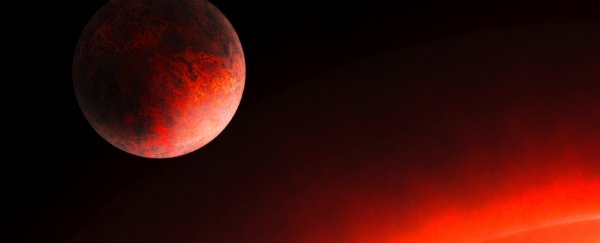An absolute oddball of a newly discovered exoplanet has been found orbiting a star just 31 light-years away.
It's called GJ 367b, and it's one of the smallest exoplanets ever discovered, just slightly larger than Mars; but also one of the most compact, with a density almost the same as that of pure iron. Furthermore, it's insanely close to its host star, completing one full orbit once just every eight hours.
Astronomers are yet to figure out how this planet would have formed, but they believe its discovery is an important one.
"From the precise determination of its radius and mass, GJ 367b is classified as a rocky planet," said astronomer Kristine Lam of the Institute of Planetary Research at the German Aerospace Center.
"It seems to have similarities to Mercury. This places it among the sub-Earth sized terrestrial planets and brings research one step forward in the search for a 'second Earth'."
The way we hunt for exoplanets results in certain biases in what we end up finding; we have two main methods. The transit method relies on looking for very small dips in starlight as an exoplanet moves (or transits) between us and its host star.
This tends to favor large exoplanets on close orbits, since a larger exoplanet will result in a bigger dip in starlight (known as a light curve), and pass in front of the star more frequently, which both confirms a periodic orbit, and allows astronomers to characterize that orbit more accurately.
The radial velocity, or wobble method relies on changes in the wavelength of a star's light as an orbiting exoplanet's gravitational pull causes it to move ever-so-slightly. Again, the more massive the exoplanet, the stronger the signal. Smaller exoplanets, generating a smaller signal, are harder to detect.
By all accounts, GJ 367b was thus something of a fortuitous discovery. Because it is so close (31 light-years is pretty close, cosmically speaking), its transits were detected by NASA's exoplanet-hunting space telescope TESS. TESS stares at regions of the sky for long periods, looking exactly for these dips in starlight.
The dips can tell us how big the transiting exoplanet is; that's how the research team figured out that the exoplanet is just over 9,000 kilometers in diameter.
Then the scientists used the radial velocity method to see how much the exoplanet's gravitational pull affects the star. This allowed them to calculate the mass of GJ 367b and thus its density – 8.106 grams per cubic centimeter. Earth's density is 5.51 grams per cubic centimeter; iron's is 7.874 grams per cubic centimeter at room temperature.
This could tell us something about the exoplanet's composition, since we have something very similar right here in the Solar System.
"The high density indicates the planet is dominated by an iron core," said astronomer Szilárd Csizmadia of the German Aerospace Center. "These properties are similar to those of Mercury, with its disproportionately large iron and nickel core that differentiates it from other terrestrial bodies in the Solar System."
To be clear, it's not possible that GJ 367b could be a second Earth. Although it is orbiting a red dwarf star about half the mass of the Sun – a much cooler type of star – its close proximity means that the exoplanet is tidally locked, with one side always facing the star, and subject to absolutely scorching radiation. On the exoplanet's day side, temperatures would sit somewhere between 1,300 and 1,500 degrees Celsius (2,372 and 2,732 degrees Fahrenheit).
That is not a habitable climate.
But the very discovery of GJ 367b could lead us to other worlds that could very well be more hospitable.
"For this class of star, the habitable zone would be somewhere between a two- to three-week orbit," said astronomer George Ricker of MIT's Kavli Institute for Astrophysics and Space Research.
"Since this star is so close by, and so bright, we have a good chance of seeing other planets in this system. It's like there's a sign saying, 'Look here for extra planets!'"
The team's research has been published in Science.
